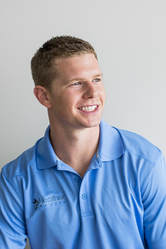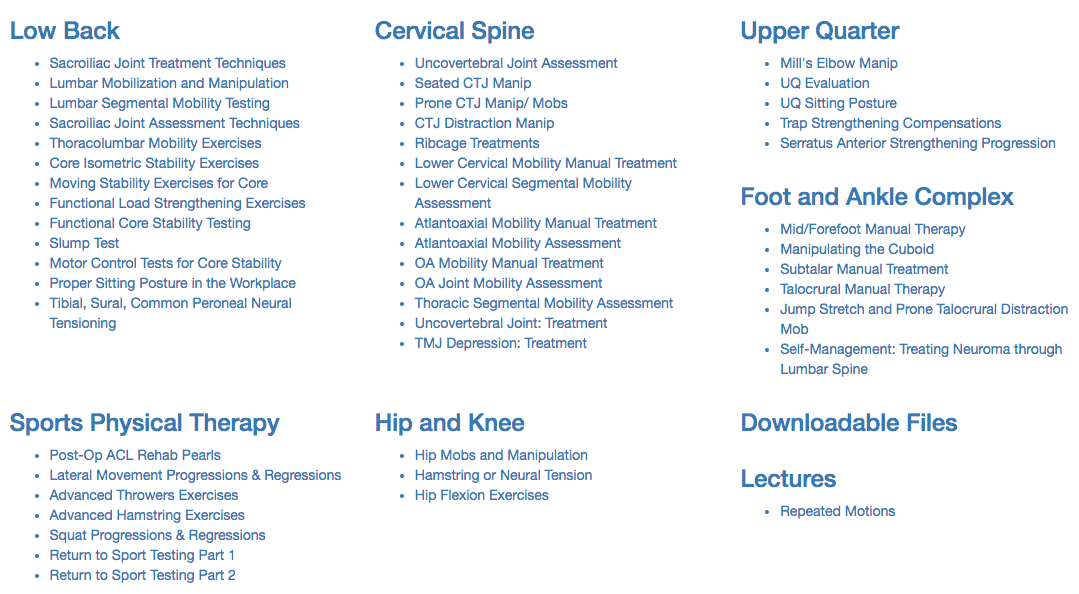- Home
- About Us
- TSPT Academy
- Online Courses
-
Resources
- Newsletter
- Business Minded Sports Physio Podcast
- Day in the Life of a Sports PT
- Residency Corner
-
Special Tests
>
-
Cervical Spine
>
- Alar Ligament Test
- Bakody's Sign
- Cervical Distraction Test
- Cervical Rotation Lateral Flexion Test
- Craniocervical Flexion Test (CCFT)
- Deep Neck Flexor Endurance Test
- Posterior-Anterior Segmental Mobility
- Segmental Mobility
- Sharp-Purser Test
- Spurling's Maneuver
- Transverse Ligament Test
- ULNT - Median
- ULNT - Radial
- ULNT - Ulnar
- Vertebral Artery Test
- Thoracic Spine >
-
Lumbar Spine/Sacroiliac Joint
>
- Active Sit-Up Test
- Alternate Gillet Test
- Crossed Straight Leg Raise Test
- Extensor Endurance Test
- FABER Test
- Fortin's Sign
- Gaenslen Test
- Gillet Test
- Gower's Sign
- Lumbar Quadrant Test
- POSH Test
- Posteroanterior Mobility
- Prone Knee Bend Test
- Prone Instability Test
- Resisted Abduction Test
- Sacral Clearing Test
- Seated Forward Flexion Test
- SIJ Compression/Distraction Test
- Slump Test
- Sphinx Test
- Spine Rotators & Multifidus Test
- Squish Test
- Standing Forward Flexion Test
- Straight Leg Raise Test
- Supine to Long Sit Test
-
Shoulder
>
- Active Compression Test
- Anterior Apprehension
- Biceps Load Test II
- Drop Arm Sign
- External Rotation Lag Sign
- Hawkins-Kennedy Impingement Sign
- Horizontal Adduction Test
- Internal Rotation Lag Sign
- Jobe Test
- Ludington's Test
- Neer Test
- Painful Arc Sign
- Pronated Load Test
- Resisted Supination External Rotation Test
- Speed's Test
- Posterior Apprehension
- Sulcus Sign
- Thoracic Outlet Tests >
- Yergason's Test
- Elbow >
- Wrist/Hand >
- Hip >
- Knee >
- Foot/Ankle >
-
Cervical Spine
>
- I want Financial Freedom
- I want Professional Growth
- I want Clinical Mastery
GENERALIST OR SPECIALIST?When I graduated with my clinical doctorate, I entered the workforce as a general Physical Therapy practitioner. In other words, I knew a little bit of information on a wide array of topics. For example, I could perform an outpatient orthopedic evaluation, but it was relatively sloppy and inefficient. During these early evaluations, I remember performing 20+ special tests and identifying upwards of 50 impairments. Looking back, I probably gathered enough information to give the patient ten different diagnosis. Unfortunately, the diagnosis’ were not clinically significant. Physical Therapy school gave me a general foundation, but I lacked expertise for ranking and prioritizing impairments (plus, the inefficiency added hours to my documentation!)* EXPERTISE REQUIRES EFFORT Similar to most physical therapists, I strive for excellence in both my personal and professional life. As a new graduate, I wanted to be a great practitioner, and I wanted to arrive at that gate quickly. The reality of becoming a clinical expert is that it always takes time and effort. You cannot shortcut your efforts because gaining experience is a key part of the process. Clinical expertise happens when research, experience, and intuition flow together. Shortcutting any aspect of this equation changes the final output. Becoming a clinical specialist in Orthopedics took months of time and preparation. I remember working my full time job as a clinic manager, enjoying a few hours with my wife, and then hitting the books from 10 p.m. to 1 or 2 a.m. They were long days. When looking back, it is natural to ask if the months of preparation were worth the ‘OCS’ credentials. The answer is a resounding, “Yes!” For me, there was no alternative. The idea of showing up to clinic average and not maximizing my results was not an option. The hard work and effort is a rite of passage from generalist to becoming a specialist. It is still the road less travelled, but a worthwhile adventure that will make you a better clinician. SPECIALIZATION MADE ME A BETTER CLINICIAN If you have remotely considered taking a specialty examination, it is likely that a colleague has said, “Why waste your time? The examination is a few years outdated and does not apply to real clinical problems.” Our profession is driven by our most up to date research. Without this research, the physical therapy profession would suffer immensely. Preparing for the Orthopedic specialty examination forced me to truly understand the research. For example, how many people perform eccentric contractions for Achilles tendinopathy? Great! Eccentrics are important. However, if your results are not 100% it is because there is more information behind the eccentric research studies. Some of the best eccentric research assessed ATHLETES with MID-PORTION Achilles tendinopathy. The athletes performed 180 repetitions each day often while working through pain. (1) The clinical practice guidelines for Achilles Pain, Stiffness, and Muscle Power Deficits Achilles Tendinitis mentions that insertional tendinopathy and non-athletes do not respond as positively to eccentric loading. An expert clinician tailors their treatment to the person, current irritability, pathology, and other biopsychosocial factors. The research helps guide the clinician on the best path and allows the expert clinician to intelligently pivot when something does not directly match our current literature. Specialization does prepare you for the clinical world! Expert practice forces you to critically analyze the decisions you make on a patient-to-patient basis. TAKE HOME ADVICE
*To clarify- this does not mean Physical Therapy school is not preparing students adequately. We are competent and safe entry-level professionals when we graduate. Physical therapy schools help people pass the NPTE. They do not have the bandwidth nor time to allow for specialization. Reference 1. Alfredson H, Lorentzon R. Chronic Achilles tendinosis: recommendations for treatment and prevention. Sports Med. 2000;29(2):135-146. OPTIM PREP COURSEOPTIM is offering $50 off the first 25 course participants with promo code First25. (Only 5 codes are still active before our October 1st launch date!) NEW TSPT INSIDER ACCESS LIBRARY!Looking for advanced sports and orthopedic content? Take a look at our BRAND NEW Insider Access pages! New video and lecture content added monthly.  About the Author: Jim Heafner PT, DPT, OCS is one of the founders of The Student Physical Therapist. He is owner of Heafner Health Physical Therapy in Boulder, Colorado.
1 Comment
|
Dr. Brian Schwabe's NEW Book in partner with PaleoHacks!
Learn residency-level content on our
Insider Access pages We value quality PT education & CEU's. Click the MedBridge logo below for TSPT savings!Archives
July 2019
Categories
All
|








 RSS Feed
RSS Feed